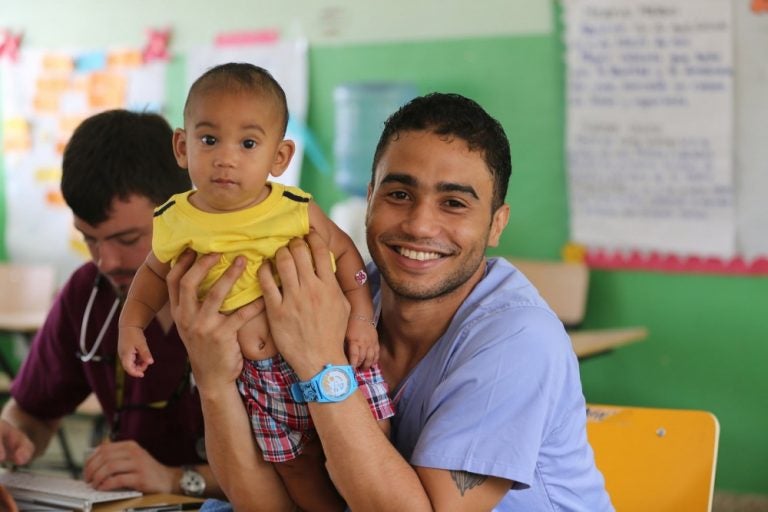The heat and humidity were oppressive and the smell of car fumes mingled with food stalls and garbage as buses carrying UCF medical and nursing faculty and students wound through the narrow downtown streets of San Francisco De Macoris in the northern Dominican Republic.
Anticipation was high as the group reached an elementary school that would serve as the day’s makeshift clinic for a rural village 30 minutes from the city. College of Medicine faculty member Dr. Judy Simms-Cendan led the 49-person medical mission team July 23-31, the fourth trip she has made as director of the college’s global health initiatives.
This year’s team was the largest to date and included UCF medical, nursing and engineering students, University of Florida pharmacy students, their faculty, community dentists and doctors, and a pastor. During the eight days, the team cared for 864 patients, 300 more than last year, in six impoverished communities with virtually no health care services. And they worked together, bringing to life the team approach to care that Simms-Cendan and others model at the medical school.
“We have learners at different levels, fourth years (students) teaching second years, faculty from various backgrounds and community practitioners to help our students see and learn on their feet and see the relevance of what they’ve learned in the classroom,” said Simms-Cendan.
The interprofessional approach to medicine is also something that health experts in the United States have been advocating more and more to help enhance patient care. The trip to the Dominican Republic offered UCF students a chance to live that team approach in some very trying conditions.
The elementary classrooms-turned clinic rooms were dark and sparsely furnished so the team brought in its own generator to ensure constant electricity for light, dental compressors and the iPads they used for completing electronic health records. The goal is to track patients, assess their progress year after year and keep records of medications. The information will be useful for future visiting medical teams needing patients’ medical histories.
To see a video about the team’s visit click here.
Second-year medical student and trip coordinator Camille Carre led the day’s activities by organizing teams of interprofessional students and faculty who rotated through the different rooms set up to deal with triage, internal medicine, pediatrics, OB-GYN, dental, patient education and the pharmacy.
More than 100 people were already waiting to be seen when the medical team arrived the first day. Their complaints ran from aches and pains to diabetes and parasites. “There’s nothing like this trip to truly open your eyes to the medical needs here,” Carre said.
Fourth-year medical student Neesha Patel, who was on her second trip to the island, partnered with younger students to triage and assess patients. “It’s wonderful to see how the trip has grown in two years,” she said.
One of the new services offered to locals this year was dental care, provided by five Sarasota dentists who performed procedures from cleanings to extractions. As Patel helped patients and taught students, dentist Dr. Janet Alberti-Bailey explained how poor diet and high sugar consumption were impacting residents’ teeth. One of the first procedures of the day was a tooth extraction performed by oral surgeon Dr. Scott Middleton while students watched and learned. The interprofessional aspect of the learning and teaching is something Simms-Cendan stresses.
“We have medical and nursing students enjoying the opportunity to see dental care. It’s anatomy and surgery, which they wouldn’t ordinarily get exposed to and would never happen unless it’s on a trip like this,” Simms-Cendan said.
Faculty members hope the interdisciplinary training helps build teamwork “muscle memory” that students will take into their future careers.
Among the community physicians who volunteered were Dr. David Simmons, an internist, and his wife, Chaplain Linda Simmons, who offered pastoral counseling. “The Dominican people are very spiritual,” said Simms-Cendan. “They don’t always have people to discuss their problems with and often it’s easier to talk to a stranger than to a family member about personal problems.”
While the medical team cared for patients, five UCF engineering students from Engineers Without Borders and their faculty advisor, Jesse Berdis from NASA, met with local leaders about the village’s biggest infrastructure need – a bridge to cross the river that runs through the community. When waters are high, the river isolates residents and is treacherous to cross. During their visits, the engineers surveyed the land and took soil samples to gauge the stability of the rocky soil bed for future construction.
“It’s amazing that in a few years, this community will have a bridge,” said UCF engineering student Becca Shea. The team analyzed the area to design the best type of bridge that will be cost-effective to build and easy to maintain.
As the week progressed, the health care students grew more confident in working together, using their medical Spanish and providing care even with limited space, equipment and drugs.
“I got valuable practice taking histories and giving advice,” said second-year student Daniel Stehli, “I got to diagnose a woman with diabetes and truly helped her start to turn her health around. It doesn’t get more real than that.”
The students raised money for the trip months in advance and collected donated supplies and medications. The Diebel Legacy Fund of Central Florida Foundation – a long-time supporter of the medical mission trip – donated $10,000 to fund travel scholarships for the medical students to encourage and support volunteer medical initiatives to help the underserved.
